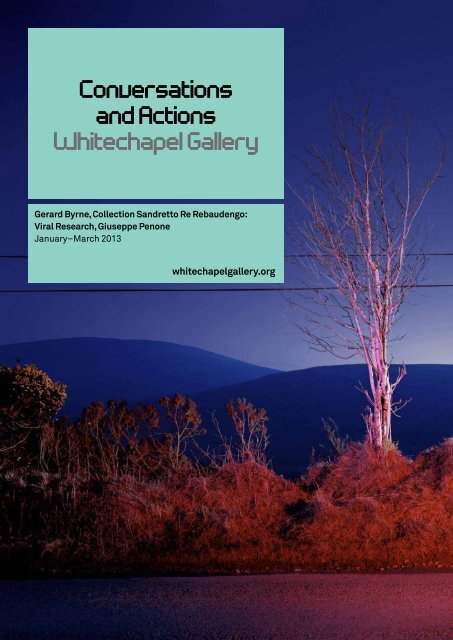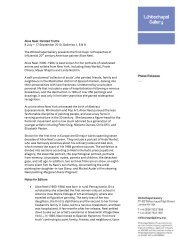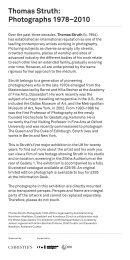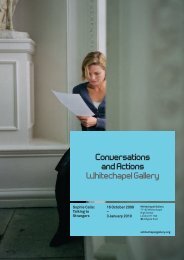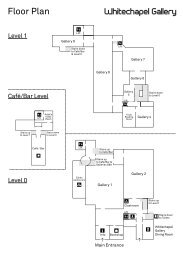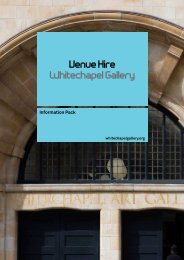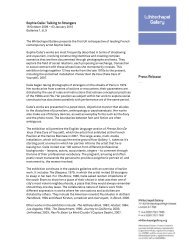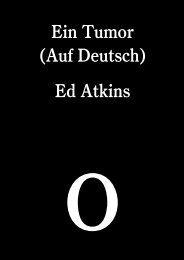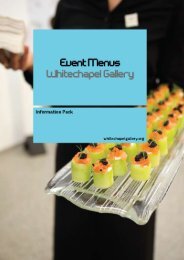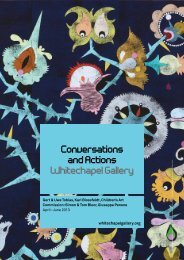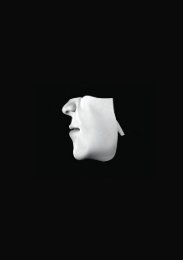Download - Whitechapel Gallery
Download - Whitechapel Gallery
Download - Whitechapel Gallery
You also want an ePaper? Increase the reach of your titles
YUMPU automatically turns print PDFs into web optimized ePapers that Google loves.
Conversationsand Actions<strong>Whitechapel</strong> <strong>Gallery</strong>Gerard Byrne, Collection Sandretto Re Rebaudengo:Viral Research, Giuseppe PenoneJanuary–March 2013whitechapelgallery.org
Introduction: Conversations & ActionsConversations & Actions has been put together by the <strong>Whitechapel</strong> <strong>Gallery</strong>’s EducationDepartment to introduce primary and secondary school teachers to each season ofexhibitions and new commissions at the <strong>Gallery</strong>. It explores key themes within theexhibitions on display by suggesting questions to spark conversation, discussions aroundworks on which to focus, as well as proposing ideas for practical activities that can berealised either in the <strong>Gallery</strong> or back in the classroom.Illustrations and artists’ quotes are included throughout along with links to furtherinformation about the artists and works. In addition to using the information withinthis resource, we recommend your own complimentary research, identifying anycross-curricular connections with other subject areas in advance of your visit. We alsorecommend calling the <strong>Gallery</strong> in advance to discuss your visit, availing of our studio spaceswhich can be booked free of charge, as well as other events at the <strong>Gallery</strong> listed at the endof this resource.We hope you enjoy your visit.
Winter 2013 at the <strong>Whitechapel</strong> <strong>Gallery</strong>Winter 2013 sees a wide variety of new exhibitions and commissions arriving at the<strong>Whitechapel</strong> <strong>Gallery</strong> including Gerard Byrne’s major solo survey A state of neutral pleasureinvolving photography, film and installation; a group display of black and white works fromthe Sandretto Re Rebaudengo Collection entitled Viral Research, and Lucy Cash’s beautifulnew films as part of the Artist in Residence exhibition in the Project Galleries. GiuseppePenone’s Spazio di Luce (Space of Light) continues to captivate visitors in <strong>Gallery</strong> 2, whilethe ground-breaking Aspen Magazine: 1965-1971 is on view in the Archive <strong>Gallery</strong>.Photography and film are common to all of the new exhibitions this season includingthemes such as artists’ research and relationships between the viewer and art object ina gallery or museum. Formal simplicity, contrasted with psychological intensity can beobserved in many of the works, sometimes exposing the artifice of the image and oftenemployed with playfulness and humour.Across all works on show, there are links to Art & Design in the primary and secondaryschool curricula for art, as well as English, History, Drama, Media Studies, PSHE andCitizenship.Please note that many of Gerard Byrne’s films in <strong>Gallery</strong> 1 and 8 contain sexual referenceswhich may not be suitable for younger visitors. We advise group leaders to visit theexhibition before bringing a group to decide which works are suitable, or to use thisresource as a guide to navigating the space.Gerard Byrne: A state of neutral pleasure17 January - 8 March 2013Collection Sandretto Re Rebaudengo:Viral Research15 December 2012–10 March 2013The Bloomberg Comission:Giuseppe Penone4 September 2012–September 2013
Gerard Byrne: Representing Time (Galleries 1 & 9)Work in focus: A country road. A tree. Evening (2006-ongoing)“One thing that is really consistent is the idea ofmaking work that refers to other representationalmodes, even like the Godot trees refer to dramadirectly, or 68’ mica and glass (2008) refers to theconditions under which a scupture comes intobeing within a museological context.”Gerard Byrne, Interview with Kirsty Ogg, 2012.Look at the images at the end of <strong>Gallery</strong> 1• What’s going on in these photographs?• What is unusual about them?• Does the title give anything away?• Why and how do you think the artist took them?• How do they compare to each other?Byrne always references other artists’ within his own work. He’s interested in the attitudes that his workevidences rather than what is depicted. The title of this series is from playwright Samuel Beckett’s openingstage directions (which he was particularly strict about) for the influential tragi-comedy Waiting for Godot(1948)*.Byrne composed the photographs by lighting bare trees with colourful theatre lights in various locations inWicklow (where Beckett walked with his father in his native Ireland) and Roussillon, South of France (wherehe wrote Waiting for Godot after being in exile during World War II). The photographs propose that the play’simagined setting has a changing relationship to real physical places, through space and time although Beckettonce claimed it was inspired by Casper David Friedrich, Man and Woman Contemplating the Moon, 1824*.What does this information tell us about the playright?What does it tell us about Byrne’s relationship to Beckett’s Waiting for Godot?Action: Beyond the <strong>Gallery</strong>In this series of photographs, Gerard Byrne is recreating an imagined place in a location that may have inspiredthe setting for Beckett’s play, Waiting for Godot.Find a piece of literature or text containing a story you have read as a group (perhaps as part of another lesson)for example, Wuthering Heights by Emily Bronte.Read a passage describing the location of the story and try and visualise it.What might this setting have been inspired by? Think about the biography of the author of the text and his/ hersurroundings when writing it.In pairs, research images of the location online. Think about how this particular setting has changed over timeand of different peoples’ experience of and attitudes towards it. Try and find a number of different ways thesetting is conveyed and print them out.Compare the different results among the group.
Action: Beyond the <strong>Gallery</strong>Beckett used a number of props in this play, including turnips, a carrot, a radish, a whip, a watch, glasses, a pipe,a vaporiser, a handkerchief, a bowler hat, a pair of boots, a folding stool, a picnic basket (with a chicken and abottle of wine) and a coat.Byrne is interested in Beckett’s choice of props and organised a performance in New York in 2011 where heinvited actors to audition in front of a live audience. He invited the actors to recite from Waiting for Godot and usethe props as they pleased.Find or bring in as many of these props as you can. In groups or teams, improvise with these props or read anextract of Waiting for Godot, using the props as you go.Gerard Byrne: Media (<strong>Gallery</strong> 8 & 9)Work in Focus: Newsstands (2007-ongoing)“I’ve got a few referencial coordinates thatcontinually pop up. One of them is newspapers,another is television, and another one is magazines.”Gerard Byrne, Interview with Kirsty Ogg, 2012.What is the viewer being presented with in these series of images in the next <strong>Gallery</strong> (<strong>Gallery</strong> 9)?Where might the photographs have been taken? How many different categories of special-interest magazines ortypes of newspapers can you find?How does the image compare to a newsstand in Britain? What can the content and display of a newsstand tell usabout the culture of a city/country?How does this series of photographs compare to the first group of photographs you looked at in relation to theinvestigation of time by the artist?This series of photographs captures the temporary variety of magazines in a selection of international newsagentson a given day. The time between the instant the photograph was taken and its display in the exhibition is revealedby Byrne through the titling of the works, such as Three months and twenty days ago (2012). Newsstands offers asnapshot of socio-political history and also reminds us of the source material of much of Byrne’s film and videowork which include lesser known histories presented and discussed in magazine interviews and the media ingeneral.Action: Beyond the <strong>Gallery</strong>Find the nearest newsagent or magazine stall in your neighbourhood.Take a photo of the stand or display of magazines (you may need to ask permission from the owner).Compare your photo to those of Gerard Byrne’s, and think about the specificity of British print media and what itreveals about British culture.
Work in focus: Why it’s time for Imperial, again (21 mins)“I’ve always loved cinema, but have felt in a way abit more of a critical urgency or a critical traction inreferenceing more pervasive, less rarified forms, liketelevision, newspapers, and magazines etc. becauseI’ve always been interested in the way that thosejournalistic modes have felt like they had somehowaccess to the world.”Gerard Byrne, Interview with Kirsty Ogg, 2012.Take turns viewing Why it’s time for Imperial, again about the future of luxury cars in America.What are your first reactions to this video work?How has Byrne put it together?Where did he find his source material for the work?What aspects of American culture does it reveal?Activity: Beyond the <strong>Gallery</strong>Working in groups of 3 - 4, find an interview in a magazine you enjoy reading.Re-stage this interview with your group, deciding who will play the role of the different people involved inthe interview, who will direct the activity and who will put in place the backdrop and props to support the reenactment.Did restaging the work make you think differently about the topic being discussed?How did the way the actors behave influence this?If you could re-stage any interview from history, what would it be?Gerard Byrne: Minimalism (<strong>Gallery</strong> 9)Works in focus: ’68 Mica and GlassWhat is going on in this film?What is the environment it is set in, and who are the characters represented?How has the film been installed and screened?Why has Byrne chosen to use this medium? What is the focus of the title?68 Mica and Glass is a highly choreographed 16mm film showing two conservators* at the Van Abbemuseum,Eindhoven, disassembling and reassembling Robert Smithson’s Untitled (1968)*, revealing part of the mechanismof installing work in a museum or gallery. The work echoes A thing is a hole in a thing it is not (located in <strong>Gallery</strong>1 as part of the 24 hour screening of different works), in relation to Byrne’s interest in the discourses generatedaround Minimalism* in the 1960s. It also provides another meditation on time. The work is never shown in a state ofcompletion, with the conservators caught in a permanent loop – like a continual performance.Action: In the <strong>Gallery</strong>The people represented in ’68 Mica and Glass are performing a routine activity at the museum they work in.Can you think of routine tasks that you undertake at school or as part of your daily activity? Split into pairs anddevise 60 second mimes of a routine task you undertake on a regular basis.Mime the activity for your partner over and over again a few times, asking them to guess what you are trying to do.Has slowing down and performing a daily routine task made you think about it in a different way?
Sandretto Re Rebaudengo: Viral Research<strong>Gallery</strong> 7What is your first response to this display?What themes link the work in the room?Which work is the title based on and how does it connect to other works in the display?Action: In <strong>Gallery</strong>Split into pairs. One person looks at the artworks in terms of what they are made of and how they are constructed(the object). The other looks at the work in terms of what they’re about and what they’re trying to tell us (thesubject). Compare notes and discuss sharing with the wider group.Working across a variety of materials and scales, the works in this exhibition share a sense of precariousbalance which is heightened by the absence of colour. At the centre of the room stands a sculpture by the artistCharles Ray. The glass vessels of Viral Research (1986) visually combine clinical perfection with the anxiety ofcontamination, a recurring theme for the display.Work in focus: Eva MarisadiLook closely at the work by Eva Marisaldi.What do you see?What can you read?Can you read anything into the symbolism of the knives and the fact they are handle-less?Italian artist Eva Marisaldi has engraved eight handle-less knives with Italian words and phrases (listed belowwith translation). They are reflective of her work as a whole (encompassing sculpture, drawing, textiles, video anddigital animation), where she often captures snippets of language from conversations or written texts hinting at thecomplexity of how we inhabit, move through and perceive the world.Ricordare Questo – Remember thisCorpo Diplomatico – Diplomatic peopleMondo di Febbri – Fever of the WorldUna Complicazione – A complicationIn atti – EnactVisitori – VisitorsNecessario – NecessaryQuesto non posso, e troppo – This is too much, I cannotAction: In <strong>Gallery</strong> or BeyondWith a partner, imagine the kind of dinner table conversations that may have inspired this work, using the wordsas prompts to build up a series of dialogues.Perform them for the group.
Work in focus: Cindy ShermanLook at the photos by Cindy Sherman.What do they remind you of?What kind of atmosphere or mood are present in the works?Do you feel like you should be looking at these works?Who is the character in the different images – does the same person appear in each photo?American artist Cindy Sherman is an influencial artist who has made a huge contribution to the history ofphotography, raising key questions about representation, identity and the construction of the photographic image.She works in series and is influenced by art-historical, mass-media and popular imagery from cinema, magazines,advertising and television. Since the 1970s, she has featured in her own work by dressing up in different disguisesusing elaborate make-up, costume, sets and props, allowing her to inhabit a multitude of roles and persona.Action: In <strong>Gallery</strong> or BeyondSplit into groups of 3 and choose an image to focus on.What has just happened and what is about to happen?Who is the character and what are their intentions?Build up a narrative for the image and tell the story to the rest of your group, playing different characters who mayhave been involved in the scene before or after the one captured by the camera.Is there an overall world that has been built up in the group’s imagination?What kind of world is it?
The Bloomberg Commission: Giuseppe Penone: Spazio di Luce (Space of Light)<strong>Gallery</strong> 2Repeating the forestA shelter, a ceiling of trees, a floor of trees, a wall of trees. If you look at a ceiling, a floor, a wall of wood, you see thetrunks, branches, leaves. It is helpful if you can understand from the design of the wood the shape of the trunk, ofthe branches, of every single tree. The glance that runs along the wood’s structure, passes across the shape of thetree asinsects have done.Giuseppe Penone, 1969Walk around Penone’s sculpture of a tree, looking inside, through and all around the space of the <strong>Gallery</strong>.If you are drawn to touching the sculpture, go ahead.The sculpture was made specifically for this former library space.How does the bronze cast of a tree relate to the history of the space?What else do you notice in the space?Does encountering the sculpture remind you of an experience you have had outdoors?How does the atmosphere in the <strong>Gallery</strong> compare to that of the street outside?The latest Bloomberg Commission for <strong>Gallery</strong> 2 is of the work of Italian artist Giuseppe Penone (b. 1947, Garessio,Italy), who over the past 45 years has examined society’s understanding of nature, insisting that the spheres ofculture and nature are inextricably linked. In the late 1960s, he became associated with the innovative Italiangroup, Arte Povera who, inspired by the radical politics of the time and frustrated by the limitations of academicart education, embraced diverse sculptural practices and materials for their work to have a wider social impact.Trees and nature have been a consistent theme and life-long preoccupation in Penone’s work. In his early career,he performed many ‘actions’ or performances (which survive only as photographs) that took place in forests nearTurin and his home town of Garessio.The Bloomberg Commission: Giuseppe Penone, Spazio di Luce, installation View, Photo: David Parry / PA Wire.
Work in Focus: Spazio di Luce, 2012Why is this work called Space of Light?Why do you think the artist allows you to touch it when usually you can’t touch sculpture in a <strong>Gallery</strong>?What is it made from and how was it made?What does a tree symbolize to you?This bronze cast of a larch tree felled in a valley in Turin was made through an ancient process called ‘lost wax’casting, where the interior and exterior of the tree are deliberately reversed. It was cut into stand alone sectionsin Penone’s studio, covered in a layer of silicone, then wax and finally plaster. Liquid bronze was poured into thearea where the wax was, melting it and creating a layer of bronze. The interior was painted with gold leaf. It isimportant for Penone that the material is bronze - a natural, vegetable product that was heated by burning wood,linking to the lifecycle of the tree. The pieces become animated in the space with an identity of their own.When we look up at a tree vertically, we see how they move towards the light (this is how they grow), but inPenone’s piece the light is within. The artist is interested in how we relate to the natural world through touch- for example in the case of finger prints being left by workers. He feels it is important to understand throughtouch rather than sight – one of the primary reasons he moved from painting to sculpture as an artist. AlthoughSpazio di Luce is a monument to nature, it is not the artist’s intention for it to be a statement on contemporaryenvironmental issues. Penone is interested in human interaction with and perception of the environment, and ourrelationship to the eco systems we inhabit, believing the immediate encounter to be of utmost importance.Action: In the <strong>Gallery</strong> and beyondMaterials: paper, charcoal, graphite, pencilLook around the space you are in (whether it’s the <strong>Gallery</strong> or your school) at a piece of wood in the floor/ ceilingor as part of a piece of furniture.Using frottage*, get to know the piece of wood by rubbing its different edges with charcoal or graphite on paper.Find out what tree it is made from and what it may have looked like as a young sapling.Action: In the <strong>Gallery</strong> and BeyondMaterials: pens/pencils and paperThroughout his career, Penone has reflected on his work by writing poetic sayings. Create your own poem inresponse to Spazio di Luce and the space it is in:Think about what the former library that is now home to Penone’s work would have looked like, and write downsome descriptions – e.g. walls lined with books, people reading etc.Think about what the <strong>Gallery</strong> is used for now by observing other people in the space.In a text titled Repeating the Forest, Penone talks about the trees that the walls, ceiling and floor used to bemade from; write some descriptive text or a poem about how the gallery used to be a library and what it’s usedfor now.
Useful definitions/ informationWaiting for Godot (1948)A play by Samuel Beckett where 2 characters (Vladimir and Estragon) wait endlessly and in vain for the arrival ofsomeone named Godot. Godot’s absence, as well as numerous other aspects of the play, have led to many differentinterpretations since the play’s premiere.Casper David Friedrich (1774 – 1840)A 19th-century German Romantic landscape painter, generally considered the most important German artist of hisgeneration.ConservatorProfessional who works on the conservation of objects, determining their structural stability, addressing chemicaland physical deterioration over time, and performing corrective treatment where necessary. All their applied workmethods have to be gentle, reversible, and be traceable.Robert Smithson (1938–1973)American artist famous for his Land Art. He primarily identified himself as a painter during this time, but after athree-year rest from the art world, Smithson emerged in 1964 as a key figure of the emerging minimalist movement.MinimalismMinimalism set out to expose the essence or identity of a subject through eliminating all non-essential forms,features or concepts. As a visual arts movement it is identified with developments in post–World War II WesternArt, most strongly with American visual arts in the 1960s and early 1970s. Prominent artists associated with thismovement include Carl Andre, Dan Flavin, Donald Judd, Agnes Martin and Robert Morris.Find Out MoreGerard ByrneA Family Trail of the Gerard Byrne exhibition by Greg and Gary of Lone Twin is available from reception. (£1)Find out about times of screenings, events and the catalogue here: whitechapelgallery.org/exhibitions/gerard-byrneGiuseppe PenoneMaterial from Penone’s archive is included in a series of displays on show in an adjacent space, including writings,sketches and photographs.To view the film and to find out more about the catalogue and events visit:whitechapelgallery.org/exhibitions/the-bloomberg-commission-giuseppe-penone-spazio-di-luceA film about Spazio di Luce is available to view in the foyer and at the following link:whitechapelgallery.org/exhibitions/the-bloomberg-commission-giuseppe-penone-spazio-di-luceViral ResearchFind out more here:whitechapelgallery.org/exhibitions/collection-sandretto-re-rebaudengo-viral-researchEducation EventsTo book your free group self-led visit and to use our Education Space (available Tuesday, Wednesday and Thursdayduring term time) please call Education on 020 7522 7888 or email education@whitechapelgallery.org.More information on Schools, Family, Youth and Community Programmes linked to the exhibitions is available herewhitechapelgallery.org/education.If you have enjoyed Conversations & Actions or have any other feedback please let us know. For more Conversations& Actions visit whitechapelgallery.org/education.


